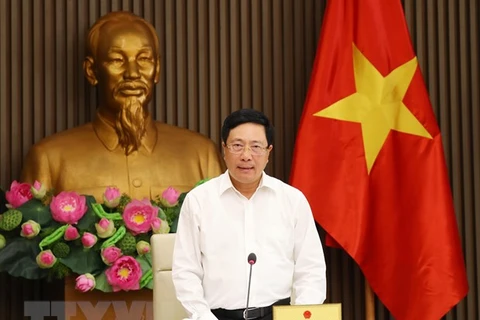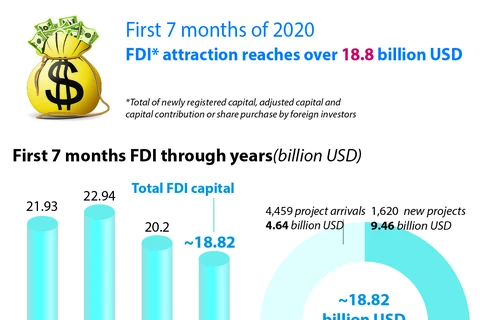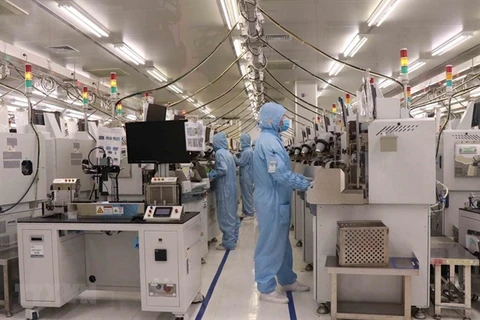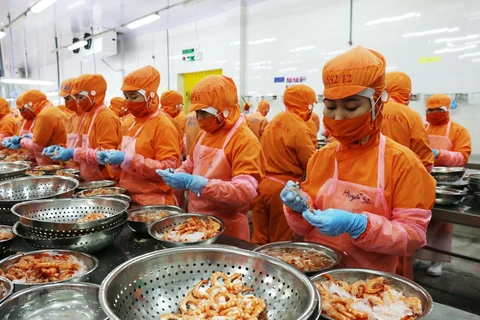HCM City (VNA) - Foreign investment in Ho Chi Minh City has totalled 2.37 billion USD this year, including new and additional capital and share purchases, down 32.9 percent year-on-year.
There were 598 new projects with registered capital of 355.9 million USD, down 11.8 percent in volume and 48.3 percent in value. Some 113 projects added capital of 209.2 million USD.
More than 2,400 purchases of shares were made by foreign investors, worth more than 1.81 billion USD, down 27.8 percent year-on-year.
The trade sector led in terms of registered capital in the first seven months, with 624.1 million USD, accounting for 26.2 percent of the total. It was followed by real estate, with 441.6 million USD, or 18.6 percent, manufacturing and processing 315.6 million USD, or 13.3 percent, information and communications 149.4 million USD, or 6.3 percent, and construction 113.1 million USD, or 4.8 percent.
Investors from 104 countries and territories have registered new projects, added capital, or purchased shares this year. Singapore led the way, with 570.1 million USD, or 24 percent of the total, then the Republic of Korea with 357.9 million USD, or 15.1 percent, Japan 331.1 million USD, or 13.9 percent, the Cayman Islands 261.9 million USD, or 11 percent, the British Virgin Islands 137.6 million USD, or 5.8 percent, and the Netherlands 118 million USD, or 5 percent.
In order to become a popular destination among foreign investors post-pandemic, Director of the municipal Department of Planning and Investment Le Thi Huynh Mai said the city will focus on upgrading infrastructure, allocating capital to key transportation projects, and stepping up the progress of construction works.
It will also accelerate administrative reform and the building of several industrial parks (IPs), including a hi-tech IP on 380 ha in Binh Chanh district.
According to Savills Vietnam’s June global survey, Vietnam still leads in attracting global corporations thanks to its low costs and modern manufacturing facilities.
In 2019, the city attracted 8.3 billion USD worth of foreign investment, with its labour productivity being nearly three times that of the whole country (299.8 million VND per person, an increase of 6.8 percent over 2018).
Meanwhile, the total number of international visitors to the city reached 8.5 million, a year-on-year increase of 14 percent with revenues up by 14.5 percent over 2018
The local gross regional domestic product (GRDP) reached more than 1.34 quadrillion VND, an 8.32 percent increase year-on-year.
Before the outbreak of COVID-19, the city set a target of achieving a growth rate of 8.5 percent for GRDP in 2020, with total private investment accounting for 35 percent of GRDP.
This year, HCM City also aims to have 44,000 new businesses, creating 135,000 new jobs.
The city has more than 74 recognised science and technology businesses out of around 200 nationwide. Ninety percent of enterprises in HCM City are micro- or small-sized enterprises and lack the financial and human resources for R&D.
The city has approved a science and technology market development programme, which targets increasing the value of science and technology products and services by 15 percent annually in the next five years and 20 percent in the case of key technologies./.
There were 598 new projects with registered capital of 355.9 million USD, down 11.8 percent in volume and 48.3 percent in value. Some 113 projects added capital of 209.2 million USD.
More than 2,400 purchases of shares were made by foreign investors, worth more than 1.81 billion USD, down 27.8 percent year-on-year.
The trade sector led in terms of registered capital in the first seven months, with 624.1 million USD, accounting for 26.2 percent of the total. It was followed by real estate, with 441.6 million USD, or 18.6 percent, manufacturing and processing 315.6 million USD, or 13.3 percent, information and communications 149.4 million USD, or 6.3 percent, and construction 113.1 million USD, or 4.8 percent.
Investors from 104 countries and territories have registered new projects, added capital, or purchased shares this year. Singapore led the way, with 570.1 million USD, or 24 percent of the total, then the Republic of Korea with 357.9 million USD, or 15.1 percent, Japan 331.1 million USD, or 13.9 percent, the Cayman Islands 261.9 million USD, or 11 percent, the British Virgin Islands 137.6 million USD, or 5.8 percent, and the Netherlands 118 million USD, or 5 percent.
In order to become a popular destination among foreign investors post-pandemic, Director of the municipal Department of Planning and Investment Le Thi Huynh Mai said the city will focus on upgrading infrastructure, allocating capital to key transportation projects, and stepping up the progress of construction works.
It will also accelerate administrative reform and the building of several industrial parks (IPs), including a hi-tech IP on 380 ha in Binh Chanh district.
According to Savills Vietnam’s June global survey, Vietnam still leads in attracting global corporations thanks to its low costs and modern manufacturing facilities.
Ho Chi Minh City is the largest city in Vietnam and the economic hub of the southern region. Accounting for 0.6 percent of Vietnam’s total land area and about 9 percent of the country’s population, it is part of the southern key economic zone, which also comprises Dong Nai, Ba Ria - Vung Tau, Binh Duong, Long An, Tay Ninh and Binh Phuoc provinces. In the southern economic hub, over 3,000 projects across all sectors are supported by foreign capital, while the number of registered enterprises has exceeded 100,000.
In 2019, the city attracted 8.3 billion USD worth of foreign investment, with its labour productivity being nearly three times that of the whole country (299.8 million VND per person, an increase of 6.8 percent over 2018).
Meanwhile, the total number of international visitors to the city reached 8.5 million, a year-on-year increase of 14 percent with revenues up by 14.5 percent over 2018
The local gross regional domestic product (GRDP) reached more than 1.34 quadrillion VND, an 8.32 percent increase year-on-year.
Before the outbreak of COVID-19, the city set a target of achieving a growth rate of 8.5 percent for GRDP in 2020, with total private investment accounting for 35 percent of GRDP.
This year, HCM City also aims to have 44,000 new businesses, creating 135,000 new jobs.
The city has more than 74 recognised science and technology businesses out of around 200 nationwide. Ninety percent of enterprises in HCM City are micro- or small-sized enterprises and lack the financial and human resources for R&D.
The city has approved a science and technology market development programme, which targets increasing the value of science and technology products and services by 15 percent annually in the next five years and 20 percent in the case of key technologies./.
VNA
























